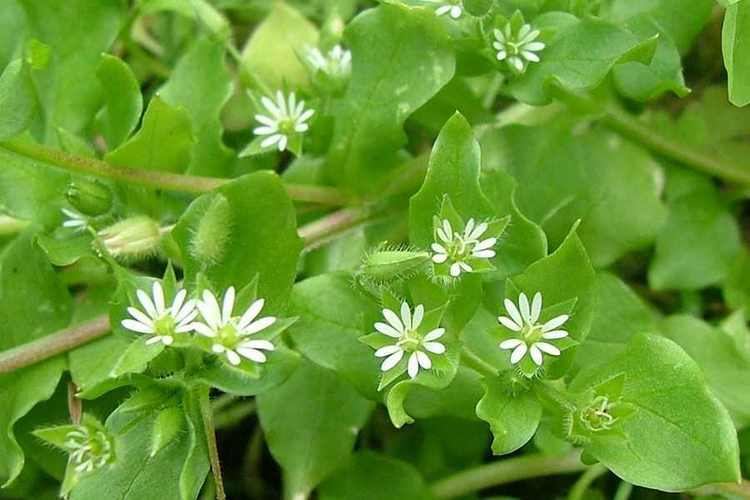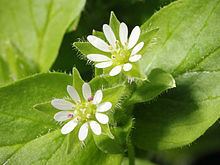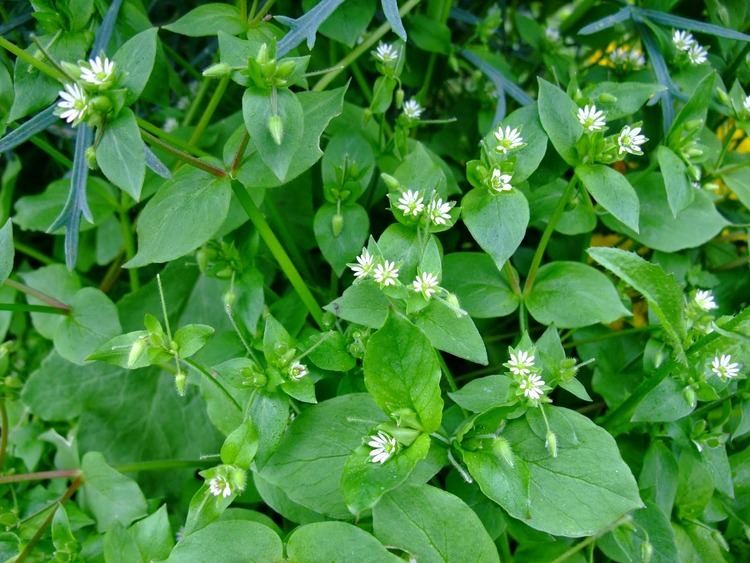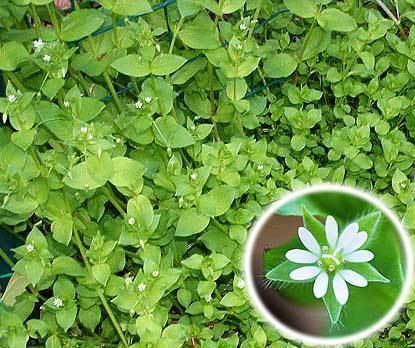Kingdom Plantae Family Caryophyllaceae Scientific name Stellaria media Rank Species | Order Caryophyllales Genus Stellaria Higher classification Stitchwort | |
 | ||
Similar Stitchwort, Cleavers, Shepherd's Purse, Lamb's Quarters, Creeping Thistle | ||
Plant portrait common chickweed stellaria media
Stellaria media, chickweed, is a cool-season annual plant native to Europe, but naturalized in many parts of North America. It is used as a cooling herbal remedy, and grown as a vegetable crop and ground cover for both human consumption and poultry. It is sometimes called common chickweed to distinguish it from other plants called chickweed. Other common names include chickenwort, craches, maruns, winterweed. The plant germinates in autumn or late winter, then forms large mats of foliage.
Contents
- Plant portrait common chickweed stellaria media
- Chickweed how to identify this tasty wild food stellaria media
- Description
- Distribution and identification
- Habitat
- Ecology
- Growth
- As food
- Toxicity
- In folk medicine
- Chemistry
- Etymology
- References

Chickweed how to identify this tasty wild food stellaria media
Description

The plants are annual and with weak slender stems, they reach a length up to 40 cm. Sparsely hairy,with hairs in a line along the stem. The leaves are oval and opposite, the lower ones with stalks. Flowers are white and small with 5 very deeply lobed petals. The stamens are usually 3 and the styles 3. The flowers are followed quickly by the seed pods. This plant flowers and sets seed at the same time.
Distribution and identification

Stellaria media is widespread in North America, Europe and Asia. There are several closely related plants referred to as chickweed, but which lack the culinary properties of plants in the genus Stellaria. Plants in the genus Cerastium are very similar in appearance to Stellaria and are in the same family (Caryophyllaceae). Stellaria media can be easily distinguished from all other members of this family by examining the stems. Stellaria has fine hairs on only one side of the stem in a single band and on the sepals. Other members of the family Caryophyllaceae which resemble Stellaria have hairs uniformly covering the entire stem. It usually has 3 stamens other references indicate 5 stamens and 3 - 8 in other references.
Habitat
Very common as a weed in waste places.
Ecology

The larvae of the European moth yellow shell (Camptogramma bilineata), of North American moths pale-banded dart (Agnorisma badinodis) or dusky cutworm (Agrotis venerabilis) or North American butterfly dainty sulphur (Nathalis iole) all feed on chickweed.
Growth

In both Europe and North America this plant is common in gardens, fields, and disturbed grounds. Control is difficult due to the heavy seed sets. Common chickweed is very competitive with small grains, and can produce up to 80% yield losses among barley.
As food
Stellaria media is edible and nutritious, and is used as a leaf vegetable, often raw in salads. It is one of the ingredients of the symbolic dish consumed in the Japanese spring-time festival, Nanakusa-no-sekku.
Toxicity
S. media contains plant chemicals known as saponins, which can be toxic when consumed in large quantities. Chickweed has been known to cause saponin poisoning in cattle. However, as the animal must consume several kilos of chickweed in order to reach a toxic level, such deaths are rare.
In folk medicine
The plant has medicinal purposes and is used in folk medicine. It has been used as a remedy to treat itchy skin conditions and pulmonary diseases. 17th century herbalist John Gerard recommended it as a remedy for mange. Modern herbalists prescribe it for iron-deficiency anemia (for its high iron content), as well as for skin diseases, bronchitis, rheumatic pains, arthritis and period pain. Not all of these uses are supported by scientific evidence. The plant was used by the Ainu for treating bruises and aching bones. Stems were steeped in hot water before being applied externally to affected areas.
Chemistry
The anthraquinones emodin, parietin (physcion) and questin, the flavonoid kaempferol-3,7-O-α-L-dirhamnoside, the phytosterols β-sitosterol and daucosterol, and the fatty alcohol 1-hexacosanol can be found in S. media. Other flavonoid constituents are apigenin 6-C-beta-D-galactopyranosyl-8-C-alpha-L-arabinopyranoside, apigenin 6-C-alpha-L-arabinopyranosyl-8-C-beta-D-galactopyranoside, apigenin 6-C-beta-D-galactopyranosyl-8-C-beta-L-arabinopyranoside, apigenin 6-C-beta-D-glucopyranosyl-8-C-beta-D-galactopyranoside, apigenin 6, 8-di-C-alpha-L-arabinopyranoside. The plant also contains triterpenoid saponins of the hydroxylated oleanolic acid type. Proanthocyanidins are present in the testa of seeds.
Etymology
Stellaria is derived from the word 'stellar' meaning 'star', which is a reference to the shape of its flowers. Media is derived from Latin and means 'between', 'intermediate', or 'mid-sized'.
